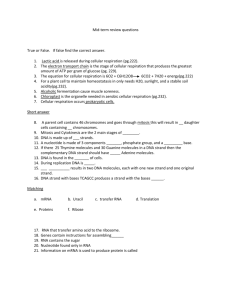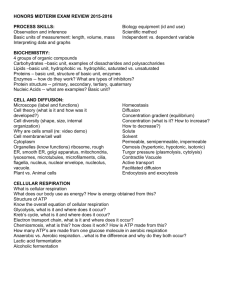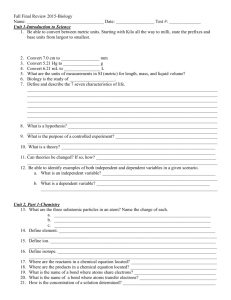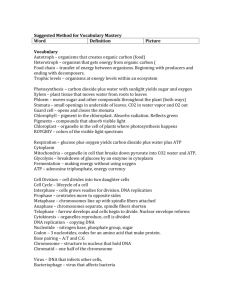Name: Period: Biology 1 Midterm Exam Review #5 (due ______) I
advertisement
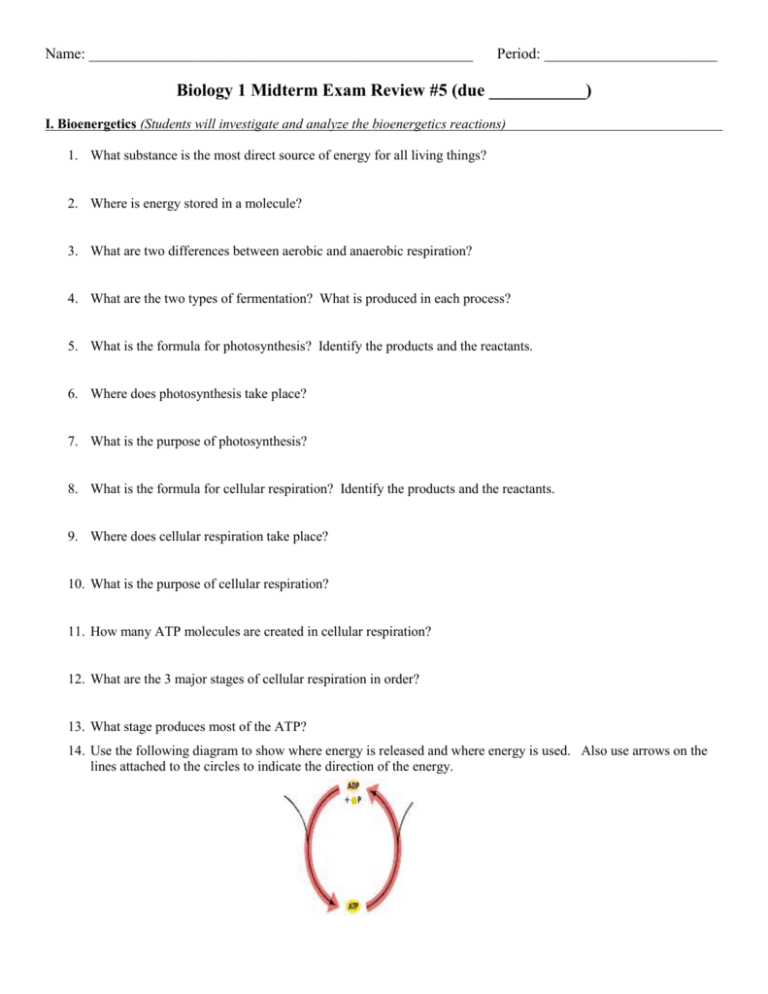
Name: ___________________________________________________ Period: _______________________ Biology 1 Midterm Exam Review #5 (due ___________) I. Bioenergetics (Students will investigate and analyze the bioenergetics reactions) 1. What substance is the most direct source of energy for all living things? 2. Where is energy stored in a molecule? 3. What are two differences between aerobic and anaerobic respiration? 4. What are the two types of fermentation? What is produced in each process? 5. What is the formula for photosynthesis? Identify the products and the reactants. 6. Where does photosynthesis take place? 7. What is the purpose of photosynthesis? 8. What is the formula for cellular respiration? Identify the products and the reactants. 9. Where does cellular respiration take place? 10. What is the purpose of cellular respiration? 11. How many ATP molecules are created in cellular respiration? 12. What are the 3 major stages of cellular respiration in order? 13. What stage produces most of the ATP? 14. Use the following diagram to show where energy is released and where energy is used. Also use arrows on the lines attached to the circles to indicate the direction of the energy. 15. How are ATP and ADP different? 16. Label the following molecules in these equations (water, glucose, oxygen, carbon dioxide, alcohol) and classify each equation as cellular respiration, photosynthesis, or alcohol fermentation. A. 6CO2 + 6H2O C6H12O6 _____________________________________________________________________- B. C6H12O6 + 6O2 6CO2 + 6H2O + ATP ____________________________________________ C. Pyruvate Ethanol + CO2 _____________________________________________________________________ 17. Which reaction requires chlorophyll? 18. What is the purpose of the chlorophyll? 19. Which reaction requires light? 20. Which organisms carry out process A? 21. Which organisms carry out process B? 22. Which organisms carry out process C? 23. Which process uses chloroplasts in eukaryotes? 24. Which process uses mitochondria in eukaryotes? Name: ___________________________________________________ Period: _______________________ Biology 1 Midterm Exam Review #6 (due ___________) J. DNA & Protein Synthesis (Students will analyze the processes associated with protein synthesis) 1. Below is a strand of DNA. Write the complementary DNA strand and label the deoxyribose, phosphates, nitrogen base and hydrogen bonds. Draw a circle around one nucleotide. 2. Describe the shape of a DNA molecule. 3. What type of bond forms between the nitrogen bases in DNA? 4. What is DNA’s function? 5. If DNA bases are universal, what makes a human and a dog different? 6. Describe the process of DNA replication. 7. Replicate the following DNA strand: 5'AATGCCGATTACA3' 8. Is the product of DNA replication different or identical to the original strand? 9. Describe the process of transcription and where it happens. 10. Describe the process of translation and where it happens. 11. What is a codon? 12. What is an anticodon? 13. If the DNA strand ATGGATTCAGTA undergoes transcription, what is the mRNA sequence? 14. After translation, what would the amino acid sequence be for this section of mRNA (from above answer). 15. Compare RNA and DNA in the following table Description DNA RNA Sugar Bases Strands Where in cell Function 16. What are the three types of RNA and what are their functions? 1) 2) 3) 17. If all the cells in an organism (cells with nuclei) have the same DNA, explain, in terms of genes, how a nerve cell functions differently from a muscle cell. 18. Why does a pancreas cell produce insulin in great amounts but a blood cells does not?

